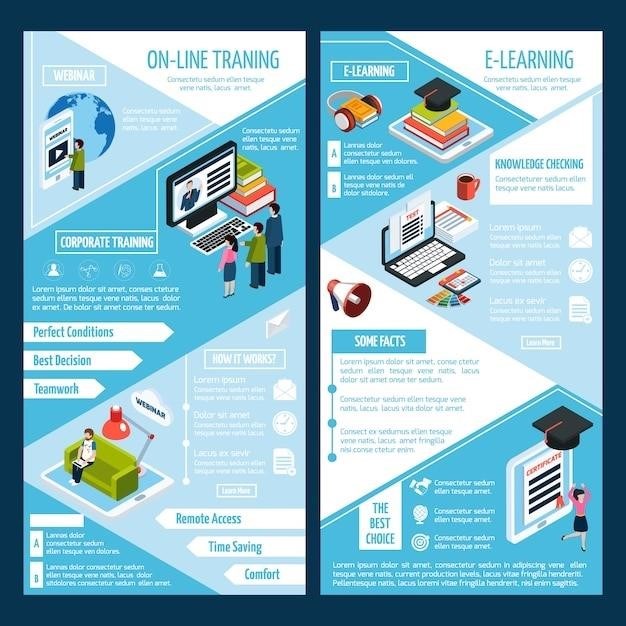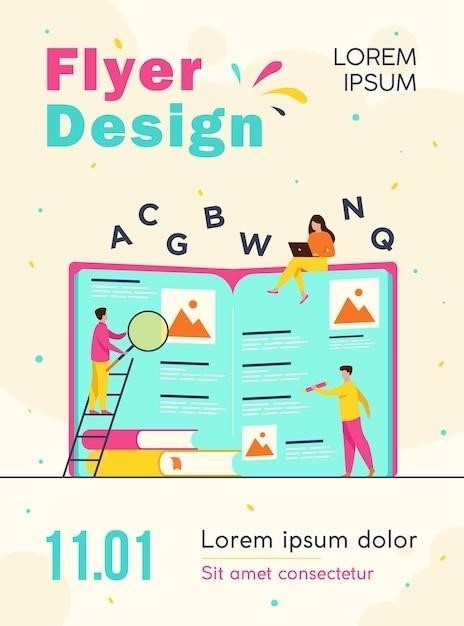Fundamentals of Instructional Design PDFs⁚ A Comprehensive Overview
This overview explores fundamental instructional design principles, their interrelationships, and systematic approaches. We examine learner-centered design and the role of technology, drawing from expert insights and practical applications detailed in numerous PDFs available online. These resources offer a foundational understanding for effective instruction.
Understanding Instructional Design Principles
Instructional design principles are foundational rules guiding the creation of effective learning experiences. These principles, rooted in learning theories and research, ensure that instructional materials and methods are aligned with how people learn best. Key principles often include considering the learner’s prior knowledge, presenting information in a clear and concise manner, providing opportunities for active learning and practice, incorporating feedback mechanisms, and fostering a positive learning environment. Understanding these principles is crucial for designing engaging and effective instruction, whether it’s a traditional classroom setting or an online learning environment. Many PDFs available online delve into specific instructional design models and theories, providing practical guidance on applying these principles to various contexts. These resources offer a wealth of information for both novice and experienced instructional designers, helping them create impactful learning experiences that meet diverse learner needs and achieve desired learning outcomes. Careful consideration of these principles ensures the creation of robust and effective learning materials.
Key Principles of Instructional Design and Their Interrelationships
Several key principles underpin effective instructional design, and their interplay is crucial for successful learning. Learner-centered design, prioritizing the needs and characteristics of the target audience, is paramount. This necessitates a thorough understanding of learners’ prior knowledge, learning styles, and motivations. A systematic approach, involving a structured process from needs analysis to evaluation, ensures a coherent and efficient design. Clarity and conciseness in presenting information are vital, minimizing cognitive load and maximizing comprehension. Active learning strategies, encouraging learner participation and engagement, promote deeper understanding and retention. Meaningful feedback mechanisms, providing learners with insights into their progress and areas for improvement, are essential for effective learning. Finally, the use of appropriate technologies and media can enhance engagement and accessibility. These principles are interconnected; for example, a learner-centered approach informs the selection of appropriate active learning strategies and feedback mechanisms. The interrelationship of these principles is explored in detail in various instructional design resources and online PDFs, offering practical guidance on creating effective and engaging learning experiences. Understanding these interconnections is key to designing truly effective instruction.
Systematic Approach to Instructional Design
A systematic approach to instructional design ensures a structured and efficient process, leading to more effective learning outcomes. This approach typically involves several key phases; Firstly, a thorough needs analysis identifies the target audience, their learning objectives, and any pre-existing knowledge or skills. Next, a detailed design phase outlines the instructional content, learning activities, and assessment methods. This phase often incorporates various instructional design models and theories to guide the development process. The development phase involves creating the actual learning materials, such as presentations, videos, or interactive exercises. Implementation involves delivering the instruction to the learners, often utilizing appropriate technologies and learning management systems. Finally, a comprehensive evaluation phase assesses the effectiveness of the instruction, measuring learner achievement and identifying areas for improvement. This iterative process allows for continuous refinement and optimization of the instructional materials and methods. Many instructional design PDFs and resources delve into specific models and frameworks for implementing a systematic approach, providing practical tools and templates for each phase. Following a systematic approach is crucial for creating high-quality, effective instruction.
Learner-Centered Instructional Design
Learner-centered instructional design prioritizes the needs, interests, and learning styles of individual learners. This approach moves away from a one-size-fits-all model, recognizing that learners possess diverse backgrounds, motivations, and preferred learning methods. Effective learner-centered design involves actively engaging learners in the learning process, encouraging active participation, collaboration, and self-directed learning. Instructional materials are tailored to accommodate various learning preferences, incorporating a variety of media and learning activities. Assessment methods are designed to provide learners with regular feedback and opportunities for self-reflection and improvement. The learning environment is designed to be supportive, inclusive, and motivating, fostering a sense of community and encouraging interaction among learners. Many instructional design PDFs emphasize the importance of understanding learning theories and applying them to create learner-centered experiences. These resources provide practical strategies and techniques for creating engaging and effective learning activities that cater to diverse learner needs and preferences. A learner-centered approach ultimately enhances motivation, engagement, and learning outcomes.

The Role of Technology in Instructional Design
Technology plays a transformative role in modern instructional design, offering powerful tools to enhance the learning experience. From interactive simulations and virtual reality to online learning platforms and mobile apps, technology provides diverse avenues for delivering engaging and effective instruction. Instructional designers leverage technology to create dynamic learning environments, incorporating multimedia elements, interactive exercises, and personalized feedback mechanisms. Online learning platforms facilitate collaborative learning, enabling learners to connect with each other and instructors regardless of geographical limitations. Mobile apps offer anytime, anywhere access to learning materials, promoting flexibility and self-paced learning. However, effective integration of technology requires careful consideration of learner needs and learning objectives. Instructional designers must ensure that technology serves as a tool to enhance learning, rather than a distraction. Many instructional design PDFs address best practices for selecting and integrating technology, emphasizing user-friendliness, accessibility, and alignment with learning goals. These resources provide guidance on creating effective eLearning courses and leveraging technology to create impactful learning experiences.

Utilizing Instructional Design Principles in Practice
This section delves into practical applications of instructional design principles. We explore how to create engaging eLearning courses and apply universal design principles to maximize accessibility and effectiveness for all learners. Real-world examples and case studies illustrate successful implementation strategies.
Applying Universal Instructional Design Principles
Universal Instructional Design (UID) ensures learning materials are accessible and usable by individuals with diverse needs and abilities. This approach moves beyond simply adapting existing materials; instead, it involves proactively designing inclusive learning experiences from the outset. Key considerations include providing multiple means of representation (e.g., text, audio, video), action and expression (e.g., writing, drawing, speaking), and engagement (e.g., offering choices, fostering collaboration, and incorporating real-world applications). Effective UID necessitates a thorough understanding of learner characteristics and preferences, including cognitive, physical, and sensory differences. By incorporating flexible learning pathways and adjustable difficulty levels, UID promotes inclusivity and optimizes learning outcomes for all participants. Resources such as the CAST (Center for Applied Special Technology) guidelines provide valuable frameworks and practical strategies for implementing UID principles effectively. Careful planning and thoughtful design are crucial for creating learning experiences that are truly accessible and engaging for everyone.
Creating Engaging and Effective eLearning Courses
Developing engaging and effective eLearning courses requires a strategic approach that blends instructional design principles with multimedia techniques. Effective eLearning leverages the power of interactive elements such as simulations, games, and branching scenarios to actively involve learners in the learning process. Short, focused modules, interspersed with regular assessments and feedback mechanisms, maintain learner motivation and provide opportunities for timely adjustments to the learning path. The use of diverse media, including videos, audio clips, and interactive graphics, caters to various learning styles and enhances knowledge retention. Furthermore, incorporating social learning elements such as discussion forums and collaborative activities fosters a sense of community and promotes peer-to-peer learning. Careful consideration of visual design, including clear navigation and intuitive interfaces, is paramount for creating a user-friendly learning experience. Regular evaluation and iterative refinement based on learner feedback are crucial for ensuring the ongoing effectiveness and engagement of the eLearning course. By thoughtfully integrating these elements, eLearning designers can create impactful and enjoyable learning experiences.
Instructional Design Models and Theories
Numerous instructional design models and theories provide frameworks for creating effective learning experiences; Understanding these models is crucial for selecting appropriate strategies and techniques. Gagné’s Nine Events of Instruction, for example, outlines a step-by-step process focusing on gaining attention, informing learners of objectives, stimulating recall of prior learning, presenting the stimulus, providing learning guidance, eliciting performance, providing feedback, assessing performance, and enhancing retention and transfer. Similarly, Merrill’s Principles of Instruction emphasize the importance of presenting information in a way that is relevant, meaningful, and engaging to the learner. The ADDIE model (Analysis, Design, Development, Implementation, Evaluation) offers a systematic approach to instructional design, guiding the process from initial needs assessment to final evaluation. Other prominent theories, such as constructivism and cognitivism, inform the design of learning activities that encourage active participation, knowledge construction, and meaningful learning experiences. The selection of a particular model or theory often depends on the specific learning objectives, target audience, and context of instruction. Exploring these various models and theories enables designers to tailor their approach to create optimal learning outcomes.
